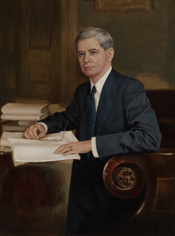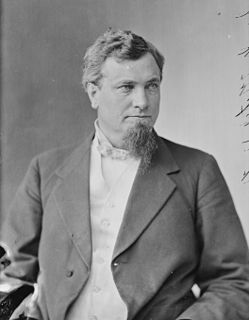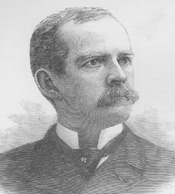
Henry Sherwood (October 9, 1813 – November 10, 1896) was a Democratic member of the U.S. House of Representatives from Pennsylvania.

The Democratic Party is one of the two major contemporary political parties in the United States, along with the Republican Party. Tracing its heritage back to Thomas Jefferson and James Madison's Democratic-Republican Party, the modern-day Democratic Party was founded around 1828 by supporters of Andrew Jackson, making it the world's oldest active political party.

Pennsylvania, officially the Commonwealth of Pennsylvania, is a state located in the northeastern and Mid-Atlantic regions of the United States. The Appalachian Mountains run through its middle. The Commonwealth is bordered by Delaware to the southeast, Maryland to the south, West Virginia to the southwest, Ohio to the west, Lake Erie and the Canadian province of Ontario to the northwest, New York to the north, and New Jersey to the east.
Henry Sherwood was born in Bridgeport, Connecticut. He moved with his parents to Catharine, New York, in 1817, and attended the common schools. During the Texas Revolution, Sherwood served in the Texas Army under Sam Houston in 1836 and 1837. He moved to Tioga County, Pennsylvania, and settled in Wellsboro, Pennsylvania, in 1840. He studied law, was admitted to the bar in 1847 and practiced his profession in Wellsboro. He was elected burgess of Wellsboro.

Bridgeport is a historic seaport city in the U.S. state of Connecticut. It is in Fairfield County, at the mouth of the Pequonnock River on Long Island Sound, 60 miles from Manhattan and 40 miles from The Bronx. It is bordered by the towns of Trumbull to the north, Fairfield to the west, and Stratford to the east.

Catharine is a town in Schuyler County, New York. The population was 1,930 at the 2000 census. The town is one of two in the county named after Catherine Montour, a Native American interpreter and leader in the area. The Town of Catharine is in the southeast part of the county and is north of Elmira, New York.

The Texas Revolution was a rebellion of colonists from the United States and Tejanos in putting up armed resistance to the centralist government of Mexico. While the uprising was part of a larger one that included other provinces opposed to the regime of President Antonio López de Santa Anna, the Mexican government believed the United States had instigated the Texas insurrection with the goal of annexation. The Mexican Congress passed the Tornel Decree, declaring that any foreigners fighting against Mexican troops "will be deemed pirates and dealt with as such, being citizens of no nation presently at war with the Republic and fighting under no recognized flag." Only the province of Texas succeeded in breaking with Mexico, establishing the Republic of Texas, and eventually being annexed by the United States.
Sherwood was elected as a Democrat to the Forty-second Congress. He was an unsuccessful candidate for reelection in 1872. He was the president of the Wellsboro & Lawrenceville Railroad and of the Pennsylvania division of the Pine Creek road. He died in Wellsboro in 1896. Interment in the Wellsboro Cemetery.

The Forty-second United States Congress was a meeting of the legislative branch of the United States federal government, consisting of the United States Senate and the United States House of Representatives. It met in Washington, D.C. from March 4, 1871, to March 4, 1873, during the third and fourth years of Ulysses S. Grant's presidency. The apportionment of seats in the House of Representatives was based on the Eighth Census of the United States in 1860. Both chambers had a Republican majority.















